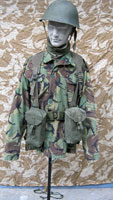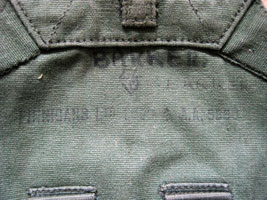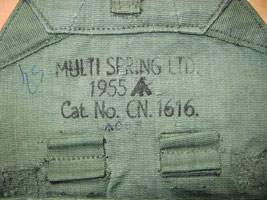Karkee Web: British & Empire Accoutrements and Personal Equipment of the Twentieth Century
Contributors' Collections: James Harriss
James Harriss is a British collector, and is a member of RMARG, the Ridgeway Military and Aviation Research Group. He is also the Finds Officer for Coleshill Uncovered. In addition to the items from his collection shown here, he has also contributed to the upcoming section on Naval Pattern 1901 Accoutrements. Jim's photos of the Manpack carrier, G.S., and Web Equipment, Pattern 1958, are also worth noting. KW hasn't yet addressed these in detail, although they are on our (long) list for the future. All photographs on this page are © James Harriss 2011.
W.E. Pattern 1937 - Set with Basic Pouches
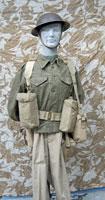


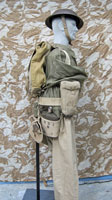 Infantryman's set in Marching Order, complete with Pack and Entrenching tool in Carrier. Note also that he's carrying a Signals satchel. KW has not yet covered this item.
Infantryman's set in Marching Order, complete with Pack and Entrenching tool in Carrier. Note also that he's carrying a Signals satchel. KW has not yet covered this item.
W.E. Pattern 1937 - Set for Personnel Armed with Pistol Only
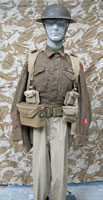
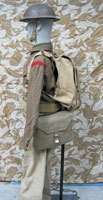
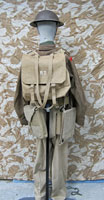
 Set for Officers and Personnel armed with pistol. It's unusual to see the Large pack in this configuration. Note also the Case, map. G.S. No. 2 Mk I Emergency Pattern. We are finalising our new section on Map Cases, and hopefully it will be published soon.
Set for Officers and Personnel armed with pistol. It's unusual to see the Large pack in this configuration. Note also the Case, map. G.S. No. 2 Mk I Emergency Pattern. We are finalising our new section on Map Cases, and hopefully it will be published soon.
W.E. Pattern 1937 - Set with Cartridge Carriers
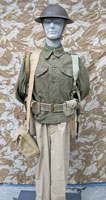

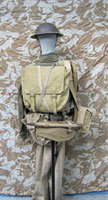
 Here is the set with Cartridge carriers. Intended for troops other than infantry, but carrying a rifle. Though the Large pack and Entrenching tool & Carrier are not usually seen in this set, for Field Service Marching Order, they would have been carried.
Here is the set with Cartridge carriers. Intended for troops other than infantry, but carrying a rifle. Though the Large pack and Entrenching tool & Carrier are not usually seen in this set, for Field Service Marching Order, they would have been carried.
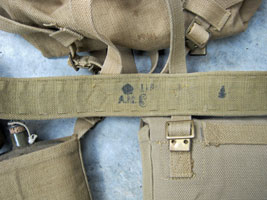
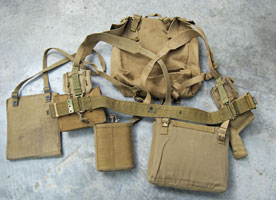 Far left, marking details of Jim's Air Ministry marked Patt. '37 Belt. RAF Patt. '37 was first issued in 1941, in blue-grey. By the start of 1942, a set of khaki Patt. ’37 was available, which was termed “drab” by the R.A.F. These will be dealt with in future sections of Karkee Web. Near left, the inside view of the officers' set shown above. So far as is known, the drab R.A.F. set had no Officer’s haversack, Compass pouch, or Binocular case.
Far left, marking details of Jim's Air Ministry marked Patt. '37 Belt. RAF Patt. '37 was first issued in 1941, in blue-grey. By the start of 1942, a set of khaki Patt. ’37 was available, which was termed “drab” by the R.A.F. These will be dealt with in future sections of Karkee Web. Near left, the inside view of the officers' set shown above. So far as is known, the drab R.A.F. set had no Officer’s haversack, Compass pouch, or Binocular case.
W.E. Pattern 1944 - Set for Rank and File (Early Issue)



 W.E. Patt. '44, set for rank and file. This is the early version - note the first issue Haversack, All Arms and Basic pouches. The Sheath, matchet, 18 inch blade, in S.C.C. 19 colour is usually associated with, but was not actually a part of, Patt. '44 W.E. It has here been replaced with the earlier leather Scabbard, matchet, 15-in. Also note the Satchel, battery staff, R.A., Mk. 2. This has been modified, probably un-officially, to have a shoulder strap. See the section below for more detail on this Satchel.
W.E. Patt. '44, set for rank and file. This is the early version - note the first issue Haversack, All Arms and Basic pouches. The Sheath, matchet, 18 inch blade, in S.C.C. 19 colour is usually associated with, but was not actually a part of, Patt. '44 W.E. It has here been replaced with the earlier leather Scabbard, matchet, 15-in. Also note the Satchel, battery staff, R.A., Mk. 2. This has been modified, probably un-officially, to have a shoulder strap. See the section below for more detail on this Satchel.
W.E. Pattern 1944 - Set for Rank and File (Late Issue)
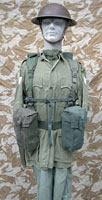
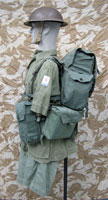

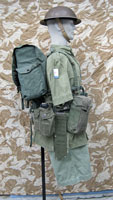 The later version of W.E. Patt. '44, set for rank and file. Here note the larger, second issue of both Haversack and Basic pouches and the Golok Sheath which replaced both the earlier Matchets. Jim has stated that, for all of his Patt. '44 photos, the uniform is a 1950s Aertex jacket, with South East Asia Command patches, over a pair of 1960 Pattern Khaki Drill Shorts (on loan from RMARG). This set also includes a Battery staff satchel. This example, like the one above, is addressed in more detail below.
The later version of W.E. Patt. '44, set for rank and file. Here note the larger, second issue of both Haversack and Basic pouches and the Golok Sheath which replaced both the earlier Matchets. Jim has stated that, for all of his Patt. '44 photos, the uniform is a 1950s Aertex jacket, with South East Asia Command patches, over a pair of 1960 Pattern Khaki Drill Shorts (on loan from RMARG). This set also includes a Battery staff satchel. This example, like the one above, is addressed in more detail below.
W.E. Pattern 1944 - Set for Officers, Warrant Officers, N.C.O.s and Specialists



 The W.E. '44 officers' set, with the first issue All Ranks Haversack in addition to the Haversack, officers.
The W.E. '44 officers' set, with the first issue All Ranks Haversack in addition to the Haversack, officers.




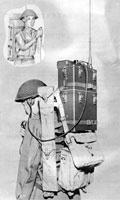 The Manpack carrier, G.S., in another item of Non-Patterned Equipment that KW has yet to address. As with so many other "jungle" items, it is closely associated with Patt. '44 but is not actually a component of the pattern. Accompanying it here is the Case, map, No. 4. The aerial case, being a "flat" one, was used with W.S. 31 and W.S. A.41. It's a Case, carrying, antennae rod, No. 5. This example is maker marked "M.E CO.", dated 1953, and carries the stores code "ZA34631". At right, a page from the 1957 dated User Handbook for Wireless Set No. 31 (Manpack), Mks. 1 & 2, showing the No. 31 set mounted on the Manpack carrier, with the No. 5 Antennae rod case mounted alongside.
The Manpack carrier, G.S., in another item of Non-Patterned Equipment that KW has yet to address. As with so many other "jungle" items, it is closely associated with Patt. '44 but is not actually a component of the pattern. Accompanying it here is the Case, map, No. 4. The aerial case, being a "flat" one, was used with W.S. 31 and W.S. A.41. It's a Case, carrying, antennae rod, No. 5. This example is maker marked "M.E CO.", dated 1953, and carries the stores code "ZA34631". At right, a page from the 1957 dated User Handbook for Wireless Set No. 31 (Manpack), Mks. 1 & 2, showing the No. 31 set mounted on the Manpack carrier, with the No. 5 Antennae rod case mounted alongside.
Indian Airborne Musette Bag (Non-Patterned Equipment)
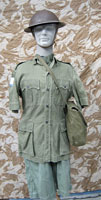

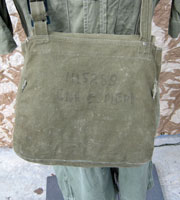 An unusual item, as described by Jim: I was talking to a stranger about WW2 stuff when he said he had an old army bag full of tools in the van, which belonged to his father during the war. At first glance I was dubious – it looked like a cheapo camping bag, but he pointed out the name and number and then rang his 92-year-old father, Gnr E Mend, 1115288, 159th Parachute Light Regiment, Royal Artillery, 44th Indian Airborne Division, to double check - Yes, definitely issued to him in India in 1944 – the only place he served. Lunch over, he donated it to RMARG. Indian Airborne Musette Bag, 1944 Non-Patterned. Made from lightweight green cotton cloth, with green enamel coated steel buckles. Adjustable shoulder strap sewn to top rear corners. Steady strap across rear (removed on this one- q,v. holes each side). Tapered sides and rounded corners similar to US M-1936 Musette bag. About the same size as the US version. Internal pocket across bottom half of rear - made from white cotton. The most notable thing about these is the mistake with the lid closure - the buckles should be attached to the lid, while the straps should be on the front, pointing upwards. As they were produced in India at very short notice this mistake was overlooked and the troops were given the excuse that it "kept snakes out" !!!! Since then another example has appeared on eBay, so that's three I've seen. I'm not a great one for serial numbers and I suspect this doesn't fit with any British pattern webbing anyway, but it is an unusual item that would be overlooked by most.
An unusual item, as described by Jim: I was talking to a stranger about WW2 stuff when he said he had an old army bag full of tools in the van, which belonged to his father during the war. At first glance I was dubious – it looked like a cheapo camping bag, but he pointed out the name and number and then rang his 92-year-old father, Gnr E Mend, 1115288, 159th Parachute Light Regiment, Royal Artillery, 44th Indian Airborne Division, to double check - Yes, definitely issued to him in India in 1944 – the only place he served. Lunch over, he donated it to RMARG. Indian Airborne Musette Bag, 1944 Non-Patterned. Made from lightweight green cotton cloth, with green enamel coated steel buckles. Adjustable shoulder strap sewn to top rear corners. Steady strap across rear (removed on this one- q,v. holes each side). Tapered sides and rounded corners similar to US M-1936 Musette bag. About the same size as the US version. Internal pocket across bottom half of rear - made from white cotton. The most notable thing about these is the mistake with the lid closure - the buckles should be attached to the lid, while the straps should be on the front, pointing upwards. As they were produced in India at very short notice this mistake was overlooked and the troops were given the excuse that it "kept snakes out" !!!! Since then another example has appeared on eBay, so that's three I've seen. I'm not a great one for serial numbers and I suspect this doesn't fit with any British pattern webbing anyway, but it is an unusual item that would be overlooked by most.
1958 Pattern Infantry Equipment: Complete Equipment Marching Order (CEMO) - (Early Issue)

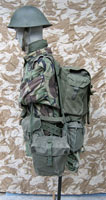
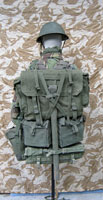
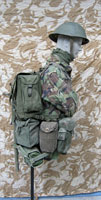 1958 Pattern early CEMO with Lightweight Pick and Respirator haversack, over '71 Pattern Combat smock. (Note that the Yoke and Pouches, rear are 2nd issue).
1958 Pattern early CEMO with Lightweight Pick and Respirator haversack, over '71 Pattern Combat smock. (Note that the Yoke and Pouches, rear are 2nd issue).
Distinguishing features:
1) Ammunition pouches are for 2 magazines and have an internal lift strap. C-hooks attach Pouches at 90° to Belt.
2) Water bottle carrier has a turn-stud closure.
3) Cape carrier - There is a strap and buckle fitting on the Pick head carrier- early versions have a black sheradised pressed brass edging on the strap end.
4) Respirator haversack is ancillary and does not attach to the webbing.
5) Generally made from a much coarser weave and heavier weight of canvas than later examples.
1958 Pattern Infantry Equipment: Complete Equipment Fighting Order (CEFO) - (Mid-period Issue)
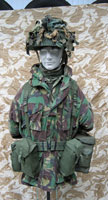
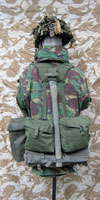 1958 Pattern CEFO, mid-period (commonest variety), over Arctic smock, 'Mao' suit, '71 Smock, 'woolypully', KF Shirt (Falklands impression). The helmet is a Falkland War veteran.
1958 Pattern CEFO, mid-period (commonest variety), over Arctic smock, 'Mao' suit, '71 Smock, 'woolypully', KF Shirt (Falklands impression). The helmet is a Falkland War veteran.
Distinguishing features:
1) Ammunition pouches for 3 magazines/ utility. C-hook attachment is angled at approx 80° to Belt, thus sweeping the lower part of the Pouch to the rear for ergonomic reasons.
2) Water bottle carrier has a strap and buckle closure.
3) Cape carrier - Pick head carrier strap has a green anodised, square, folded aluminium terminus with a central, narrow flanged, hollow rivet (as per Large pack).
4) Gas mask haversack is made from Butyl-Nylon and attaches to the Belt with a wide loop, or can be carried on its integral shoulder strap. Originally part of the 1972 Pattern Trials equipment, it was one of the few items retained and added to I.E., 1958 Pattern.
1958 Pattern Infantry Equipment - (Late Issue)
Distinguishing features:
1) These "clean" 4th issue Ammunition pouches were made without the pocket for the ENERGA grenade launcher (on right) and without the Bayonet loops on left.
2) Belt, also known as 'Working belt' is now heavy woven nylon with a pair of rectangular steel loops (1990 style) on lower rear for the Cape carrier to attach to. Blackened brass buckle at front, with brass sliders and C-hook length adjustment (1937 style).
(Not Shown) the Yoke has had the Spigot Carrier for the Lightweight Shovel cut off. This was a very common 'field' adaptation, as it got in the way of wearing a Bergen rucksack.
Associated but not part of Pattern 1958:
1) Nylon First field dressing pouch - (1972 style).
2) Night vision goggle pouch, Butyl-Nylon with plastic 1972 style D-rings (for shoulder strap) with 1958-style Keyways for attachment to the Belt.
1958 Pattern Infantry Equipment - Ancillary and Associated Equipment (Early to Mid-period Issue)
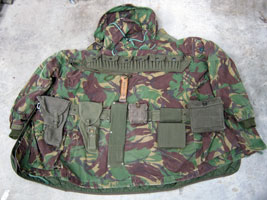 Some of these items are included in I.E., Patt. 1958, whilst others are N.P.E. but associated with Patt. '58.
Some of these items are included in I.E., Patt. 1958, whilst others are N.P.E. but associated with Patt. '58.
Top: Belt, primers.
Below, left to right:
1) 1958 Pattern Holster, for the 9mm Browning Hi-Power (replaced item 2).
2) Canadian 1951 Pattern Holster, for the 9mm Browning Hi-Power. Britain bought thousands of these for use with Patt. '44 and Patt. '58 webbing.
3) Golok in Sheath. Originally issued with (but not part of) W.E., Patt. '44, these replaced the earlier Machet, 18-inch, and its Sheath, and were used with both Patt. '44 and '58.
4) 1958 Pattern Compass pouch.
5) CN 8465-99-135-7280 Socket, rifle supporting (made and QMSed to Ulster, but never actually issued to troops).
6) 1958 Pattern Binocular case.
Stores Ref. A1/AA 5530 Satchels, battery staff, R.A., Mk. 2
Stores Ref. CN 1616 Satchels, battery staff, R.A., Mk. 2
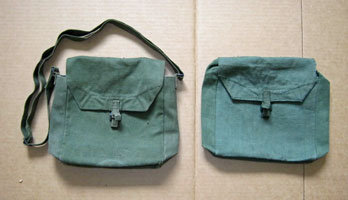
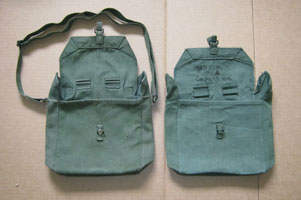 Two interesting examples of the Royal Artillery Battery staff satchel. It was originally introduced as part of the Web Equipment, Royal Artillery, LoC §A5971, approved 24 April 1931. W.E., R.A. was declared obsolete in 1939, but this Satchel was one of the few survivors, continuing in service until 1976. W.E., R.A. was the largest pattern ever produced b y M.E. Co., and KW intends to one day cover it in detail. The pattern was originally produced in khaki, of course. The khaki version of this Satchel was given stores code A1/AA 1615, whilst this S.C.C. 19 version was designated A1/AA 5530. In 1951, LoC §C4686 moved all of the AA codes into Section CN of the Catalogue of Clothing and Necessaries. The Battery staff satchel was allocated a new stores reference, CN 1616.
Two interesting examples of the Royal Artillery Battery staff satchel. It was originally introduced as part of the Web Equipment, Royal Artillery, LoC §A5971, approved 24 April 1931. W.E., R.A. was declared obsolete in 1939, but this Satchel was one of the few survivors, continuing in service until 1976. W.E., R.A. was the largest pattern ever produced b y M.E. Co., and KW intends to one day cover it in detail. The pattern was originally produced in khaki, of course. The khaki version of this Satchel was given stores code A1/AA 1615, whilst this S.C.C. 19 version was designated A1/AA 5530. In 1951, LoC §C4686 moved all of the AA codes into Section CN of the Catalogue of Clothing and Necessaries. The Battery staff satchel was allocated a new stores reference, CN 1616.
The example far left is maker marked "Finnegans Ltd.", and appears to be dated 1950, although the date is unclear. The shoulder strap is not an original feature, but an in-service addition. The second example, near left in the photos, is maker marked "Multi Spring Ltd.", dated 1955, and bears the proper CN 1616 stores reference.
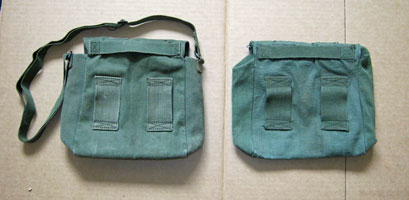 Rear views of the two Satchels shown above.
Rear views of the two Satchels shown above.
